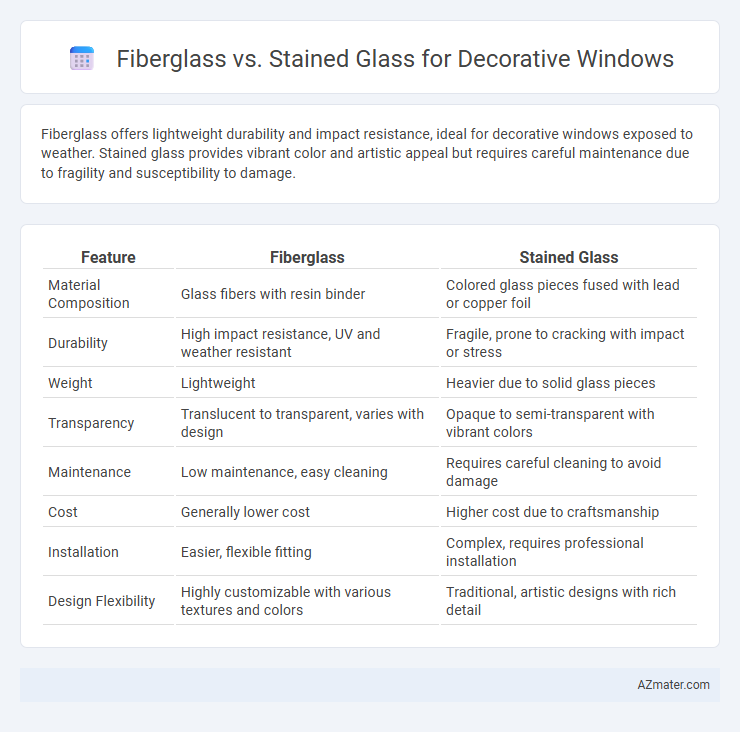Fiberglass offers lightweight durability and impact resistance, ideal for decorative windows exposed to weather. Stained glass provides vibrant color and artistic appeal but requires careful maintenance due to fragility and susceptibility to damage.
Table of Comparison
| Feature | Fiberglass | Stained Glass |
|---|---|---|
| Material Composition | Glass fibers with resin binder | Colored glass pieces fused with lead or copper foil |
| Durability | High impact resistance, UV and weather resistant | Fragile, prone to cracking with impact or stress |
| Weight | Lightweight | Heavier due to solid glass pieces |
| Transparency | Translucent to transparent, varies with design | Opaque to semi-transparent with vibrant colors |
| Maintenance | Low maintenance, easy cleaning | Requires careful cleaning to avoid damage |
| Cost | Generally lower cost | Higher cost due to craftsmanship |
| Installation | Easier, flexible fitting | Complex, requires professional installation |
| Design Flexibility | Highly customizable with various textures and colors | Traditional, artistic designs with rich detail |
Introduction to Decorative Window Materials
Fibre glass decorative windows offer durability, lightweight design, and resistance to weathering, making them ideal for long-lasting installations in various climates. Stained glass provides a rich aesthetic appeal with vibrant colors and intricate designs, often used to create artistic focal points in residential and religious buildings. Both materials serve unique purposes in decorative window applications, with fibre glass emphasizing practicality and stained glass highlighting traditional craftsmanship.
What is Fibre Glass?
Fiberglass is a durable, lightweight material made from fine glass fibers woven into a fabric and coated with resin, offering excellent strength and weather resistance for decorative windows. Unlike traditional stained glass, fiberglass does not shatter easily, making it ideal for safety-conscious installations and outdoor use. Its versatility allows for intricate designs similar to stained glass, while providing enhanced insulation and lower maintenance requirements.
What is Stained Glass?
Stained glass is an artistic technique that involves coloring glass by adding metallic salts during its manufacture, producing vibrant, translucent panels often used in decorative windows. Unlike fiberglass, which is a synthetic material composed of fine glass fibers woven into a fabric, stained glass offers unique aesthetic qualities with handcrafted designs and rich color variations. Its durability and traditional craftsmanship make stained glass ideal for adding intricate, colorful motifs to architectural features.
Aesthetic Differences Between Fibre Glass and Stained Glass
Fibre glass windows offer a sleek, modern aesthetic with uniform translucency and durability, making them ideal for minimalist or contemporary designs. Stained glass features vibrant colors, intricate patterns, and varying textures created by hand-cut glass pieces, providing a rich, traditional appearance that enhances classical or gothic-themed interiors. The choice between fibre glass and stained glass depends on whether the desired decorative window emphasizes subtle elegance or artistic, colorful storytelling.
Durability and Maintenance Comparison
Fiberglass windows offer superior durability compared to stained glass, as fiberglass is resistant to cracking, warping, and weather damage, making it ideal for long-term use in decorative windows. Maintenance of fiberglass windows is minimal, requiring only occasional cleaning to preserve their appearance, while stained glass demands careful upkeep to prevent damage to the delicate glass and lead cames. The longevity and low maintenance needs of fiberglass provide a practical advantage for decorative window installations exposed to varying environmental conditions.
Energy Efficiency and Insulation Properties
Fiberglass windows offer superior energy efficiency due to their excellent thermal insulation and low thermal conductivity, reducing heat transfer and minimizing energy loss. Stained glass, while aesthetically striking, generally lacks effective insulation and can result in higher heat transfer and decreased energy efficiency. Choosing fiberglass for decorative windows enhances temperature regulation, lowers heating and cooling costs, and improves overall home energy performance.
Installation Process and Requirements
Fiberglass windows offer a straightforward installation process due to their lightweight nature and flexible sizing, requiring minimal structural modifications and standard mounting tools. Stained glass windows demand specialized installation, involving precise fitting within reinforced frames and often requiring skilled artisans to handle delicate lead came or copper foil techniques. The structural support and protective glazing needed for stained glass increase installation complexity and time compared to the more adaptable fiberglass panels.
Cost Analysis: Fibre Glass vs Stained Glass
Fibre glass windows typically cost 30-50% less than stained glass due to lower material and labor expenses, making them a budget-friendly option for decorative window projects. Stained glass requires skilled artisans and handcrafting, driving up costs to an average of $50-$100 per square foot, whereas fibre glass panels generally range from $20-$40 per square foot. Long-term durability and maintenance costs also favor fibre glass, as it resists cracking and fading, reducing future repair expenses compared to fragile stained glass.
Best Applications for Each Material
Fiberglass is ideal for decorative windows in modern, energy-efficient buildings due to its lightweight, durability, and excellent thermal insulation properties, making it perfect for large or complex window designs. Stained glass excels in historical restorations, religious buildings, and artistic installations where vibrant colors and intricate patterns highlight craftsmanship and cultural significance. Choosing fiberglass suits contemporary aesthetics and performance needs, while stained glass emphasizes traditional beauty and ornamental value.
Choosing the Right Decorative Window for Your Space
Fiberglass decorative windows offer superior durability, low maintenance, and energy efficiency, making them a practical choice for high-traffic or harsh weather environments. Stained glass windows provide unique artistic appeal with vibrant colors and intricate designs, ideal for creating a focal point or enhancing traditional aesthetics. Selecting the right decorative window depends on balancing durability needs with desired visual impact and budget constraints.

Infographic: Fibre glass vs Stained glass for Decorative window
 azmater.com
azmater.com